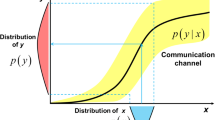Abstract
The DNA sequencing efforts of the past years together with rapid progress in sequencing technology have generated a huge amount of sequence data available in public molecular databases. This recent development makes it statistically feasible to apply universal concepts from Shannon’s information theory to problems in molecular biology, e.g to use mutual information for gene mapping and phylogenetic classification. Additionally, the genetic information in the cell is continuously subject to mutations. However, it has to be passed from generation to generation with high fidelity, raising the question of existence of error protection and correction mechanisms similar to those used in technical communication systems. Finally, better understanding of genetic information processing on the molecular level in the cell can be acquired by looking for parallels to well established models in communication theory, e.g. there exist analogies between gene expression and frame synchronization.
Similar content being viewed by others
References
The international hapmap project (2003). Nature 426(6968), 789–796. 1476–4687 (electronic) Journal Article Multicenter Study
Barker R (1953) Group synchronization of binary digital systems. In: Jackson W (ed) Communication theory. Butterworths, London, pp 273–287
Battail G (2006) Introduction to Biosemiotics: information theory and error-correcting codes in genetics and biological evolution. Springer, Heidelberg
Cilibrasi R, Vitani PMB (2005) Clustering by compression. IEEE Trans Inf Theory 51(4):1523-1545
Cox T, Cox M (1994) Multidimensional scaling. Chapman & Hall, London
Dawy Z, Goebel B, Hagenauer J, Andreoli C, Meitinger T, Mueller JC (2006) Gene mapping and marker clustering using shannon’s mutual information. IEEE/ACM Trans Comput Biol Bioinform 3(1):47–56
Dawy Z, Hagenauer J, Hanus P, Mueller JC (2005) Mutual information based distance measures for classification and content recognition with applications to genetics. In: Proceedings of the ICC 2005
Dermitzakis ET, Reymond A, Antonarakis SE (2005) Conserved non-genic sequences—an unexpected feature of mammalian genomes. Nature Rev Gene 6:151–157 URL http://www.dx.doi.org/10.1038/nrg1527
Dermitzakis ET, Reymond A, Scamuffa N, Ucla C, Kirkness E, Rossier C, Antonarakis SE (2003) Evolutionary discrimination of mammalian conserved non-genic sequences (cngs). Science 302:1033–1035
Freeland S, Wu T, Keulmann N (2003) The case for an error minimizing standard genetic code. Orig Life Evol Biosph 33(4–5):457–77
Hanus P, Dingel J, Hagenauer J, Mueller J (2005) An alternative method for detecting conserved regions in multiple species. German conference on bioinformatics, Hamburg, p 64
Hayes B (1998) The Invention of the genetic code. Am Sci 86(1):8–14
Lewin B (2004) GENES VIII. Pearson Prentice Hall Upper Saddle River, NJ
Li M, Badger JH, Chen X, Kwong S, Kearney P, Zhang H (2001) An information-based sequence distance and its application to whole mitochondrial genome phylogeny. Bioinformatics 17(2):149–154. doi: 10.1093/bioinformatics/17.2.149
Lolle SJ, Victor JL, Young JM, Pruitt RE (2005) Genome-wide non-mendelian inheritance of extra-genomic information in arabidopsis. Nature 434(7032):505–509
Lueke H (1992) Korrelationssignale. Springer, Berlin
Margulies EH, Blanchette M, Program NCS, Haussler D, Green ED (2003) Identification and characterization of multi-species conserved sequences. Genome Res. 13(12):2507–2518 URL http://www.genome.org/cgi/content/abstract/13/12/2507
Mueller J, Bresch E, Dawy Z, Bettecken T, Meitinger T, Hagenauer J (2003) Shannon’s mutual information applied to population-based gene mapping. Am J Hum Genet 73 (5 suppl) 610
Nirenberg MW, Matthaei JH (1961) The dependence of cell-free protein synthesis in e. coli upon naturally occurring or synthetic polyribonucleotides. Proc Natl Acad Sci USA 47: 1588–602. 0027–8424 (print)
Sarkis M, Goebel B, Dawy Z, Hagenauer J, Hanus P, Mueller JC (2007) Gene mapping of complex diseases—a comparison of methods from statistics informnation theory, and signal processing. IEEE Sign Proc Magaz 24(1):83–90
Shannon CE (1940) An algebra for theoretical genetics. Ph.D. thesis, Massachusetts Institute of Technology, Dept. of Mathematics
Shannon CE (1948) A mathematical theory of communication. Bell Syst Techn J 27:379–423
Shomer B, Yagil G (1999) Long W tracts are over-represented in the Escherichia coli and Haemophilus influenza genomes. Nucleic Acids Res 27(22):4491–4500
Siepel A, Bejerano G, Pedersen JS, Hinrichs AS, Hou M, Rosenbloom K, Clawson H, Spieth J, Hillier LW, Richards S, Weinstock GM, Wilson RK, Gibbs RA, Kent WJ, Miller W, Haussler D (2005) Evolutionarily conserved elements in vertebrate, insect, worm, and yeast genomes. Genome Res 15(8):1034–1050 URL http://www.genome.org/cgi/content/abstract/15/8/1034
Ueda H, Howson J, Esposito L, Heward J, Snook H, Chamberlain G, Rainbow D, Hunter K, Smith A, Genova GD, Herr M, Dahlmand I, Payne F, Smyth D, Lowe C, Twells R, Howlett S, Healy B, Nutland S, Rance H, Everett V, Smink L, Lam A, Cordell H, Walker N, Bordin C, Hulme J, Motzo C, Cucca F, Hess J, Metzker M, Rogers J, Gregory S, Allahabadia A, Nithiyananthan R, Tuomilehto-Wolf E, Tuomilehto J, Bingley P, Gillespie K, Undlien D, Ronningen K, Guja C, Ionescu-Tirgoviste C, Savage D, Maxwell A, Carson D, Patterson C, Franklyn J, Clayton D, Peterson L, Wicker L, Todd J, Gough S (2003) Association of the T-cell regulatory gene CTLA4 with susceptibility to autoimmune disease. Nature 423(6939):506–511
Ureta-Vidal A, Ettwiller L, Birney E (2003) Comparative genomics: genome-wide analysis in metazoan eukaryotes. Nat Rev Genet 4(4):251–262. 1471-0056 (print)
Wallace DC, Lott MT, Kogelnik AM, Brown MD, Navathe SB (1999) MITOMAP: a human mitochondrial genome database. URL http://www.dhgp.de/
Whelan S, Li P, Goldman N (2001) Molecular phylogenetics: state-of-the-art methods for looking into the past. Trends Gene 17(5):262–272
Author information
Authors and Affiliations
Corresponding author
Rights and permissions
About this article
Cite this article
Hanus, P., Goebel, B., Dingel, J. et al. Information and communication theory in molecular biology. Electr Eng 90, 161–173 (2007). https://doi.org/10.1007/s00202-007-0062-6
Received:
Accepted:
Published:
Issue Date:
DOI: https://doi.org/10.1007/s00202-007-0062-6




